Environmental Science > SOPHIA PATHWAY > SOPHIA PATHWAYSophia - Environmental Science - Unit 3 Milestone 3. Concepts indicated and ALL CORREC (All)
SOPHIA PATHWAYSophia - Environmental Science - Unit 3 Milestone 3. Concepts indicated and ALL CORRECT ANSWERS HIGHLIGHTED IN YELLOW.
Document Content and Description Below
SOPHIA PATHWAYSophia - Environmental Science - Unit 3 Milestone 3 Sophia - Environmental Science - Unit 3 Milestone 3 1 Correct Answers Highlighted in Yellow Select the true statement about effo... rts to address water pollution in the United States. • The Clean Water Act of 1972 stated that all U.S. waterways would be clean by 1983. • The Refuse Act of 1899 was designed to protect waterways from non-point source pollution. • Media coverage of water pollution issues in the 1960s led to public concern and political action. • Individual states address non-point pollution sources by fining citizens for violations. CONCEPT Efforts to Address Water Pollution in the United States 2 Choose the statement that is NOT true about water availability on Earth. • Industry uses nearly as much water as agriculture does. • 20% of the world’s population lives in an area where water is scarce. • Many major aquifers have a notable reduction in available water. • More than a billion people do not have ready access to clean water. CONCEPT Water Availability 3 Which of the following is an example of an organic agricultural practice? • Eliza adds earthworms to her garden to stimulate the formation of topsoil. • Sadie and her family practice no-till farming. • Rick alternates between grazing his livestock in several different pastures and giving them processed feed. • Bill uses only natural fertilizers and pesticides. CONCEPT Agriculture Impacts 4 Which of the examples below describes an effort to address urban sprawl through brownfield repair? • The site of a bankrupt cement factory is cleared and all hazardous substances disposed of. • Walking trails are built to connect neighborhoods with popular restaurants and shopping centers. • Private owners board up an abandoned building. • A flower garden is maintained in a empty lot downtown. CONCEPT Addressing Urban Sprawl 5 Which statement about agroecosystems is false? • The use of chemical fertilizers and pesticides degrades water quality. • Disrupted natural ecosystems lead to an increase in biodiversity. • Burning trees to clear land releases carbon dioxide, which increases global temperatures. • Nutrition loss in soil caused by erosion leads to the inability to grow crops. CONCEPT Agriculture Impacts 6 Which statement describes the environmental impact of developing countries? • They have limited buying power to import foods. • The standard of living in these countries requires five hectares per person. • They use the majority of the world’s fresh water supply. • These countries have an efficient food distribution system. CONCEPT Human Population Growth Agriculture Practices World Nutrition Water 7 Choose the true statement about water supply and demand. • More than three billion people do not have access to easily obtainable clean water. • Industry uses approximately half of all available fresh water on Earth. • One idea to cope with water shortages in developed countries is to make it cheaper. • The supply of available clean water is decreasing because glaciers are shrinking. CONCEPT Water Availability 8 Which of the following is NOT an impact of urban sprawl? • Reduced biodiversity • Exposure to carcinogens inside vehicles • Less need for gasoline • Less walkable cities CONCEPT Urban Sprawl in the US 9 Choose the true statement about global agricultural production. • Subsistence crops provide food products needed for survival. • Cash crops contribute to primary nutrition needs. • Tea and coffee are examples of non-food cash crops. • Corn and wheat supply over half of the worldwide human caloric needs. CONCEPT Agriculture Practices 10 Acidic water containing chemicals and heavy metals from an abandoned coal mine has washed into a nearby river. All of the following are possible outcomes of this water pollution EXCEPT __________. • An erosion of soil which enters waterways • A decrease in safe drinking water • A disruption of plant and animal life cycles • An increase in human health risks CONCEPT Water Pollution 11 A cell phone manufacturer recalled some 50 million lithium batteries installed in cell phones because the batteries were at risk of overheating and exploding. The hazardous waste characteristic of the batteries in this example is __________. • toxicity • reactivity • corrosivity • acidity CONCEPT Hazardous Waste 12 A groundskeeper on a golf course in Massachusetts imports microscopic worms from a Midwestern state to kill grubs that feed on the turf. Of the other practices he has introduced below, choose the one that is NOT an environmentally friendly form of pest control. • He uses scent to disrupt the mating cycle of a damaging beetle. • He hires someone to remove a bird population. • He removes moss with diluted, organic detergent. • He uses boiling water to kill weeds. CONCEPT Fertilizers and Pesticides 13 Select the example that describes an environmental cause of famine. • An area is flooded after heavy rains and all the crops are lost. • Local farmers lack the technical expertise to develop new cultivation strategies. • A corrupt government is overthrown and the country descends into violence. • A country's population continues to increase but incomes decrease steadily. CONCEPT World Nutrition 14 Which of the following is currently increasing because of human population growth and its associated impacts? • Freshwater supplies • Sea levels • Land available for crops • Non-renewable resources CONCEPT Population Growth Solutions 15 Choose the true statement about water on Earth. • Oceans contain approximately 90% of the water on Earth. • Freshwater is found in glaciers, ice, rivers, lakes and below ground. • Humans can easily access a large percentage of the Earth’s freshwater. • Oceans cover about 50% of the Earth’s surface. CONCEPT Water 16 Toxic chemicals are filtering through the soil into groundwater, contaminating the drinking water in a nearby town. Which type of waste disposal most likely caused this phenomenon? • Dumping at a nearby landfill. • Dumping in the harbor downstream. • Composting at the community garden. • Combustion at the town's incinerator. CONCEPT Solid Waste 17 People in developed countries consume approximately __________ of all meat. • 96% • 76% • 90% • 80% CONCEPT Agriculture Practices 18 Select the FALSE statement about the benefits and impacts of dams from those listed below. • A dam can provide hydroelectric power, which is environmentally safer than burning fossil fuels. • A dam can provide a means of irrigation to a region with poor or unpredictable rainfall. • A dam can provide a dependable water supply for urban or industrial use. • A dam can create new ecosystems, which increase biodiversity. CONCEPT Water Supply 19 Choose the statement that is NOT true about undernourishment and malnourishment in the world. • About 25% of the world’s population is undernourished or malnourished. • GMO-based farming is considered an environmentally safe method of addressing global malnourishment. • There is enough food on the planet to feed everyone; the problem is food distribution. • Most malnourished and undernourished people live in parts of Africa, Asia and Latin America. CONCEPT World Nutrition 20 Which of the following is NOT a consequence from the runoff of fertilizers into the water supply? • Poisoning of aquifers • Contaminated bodies of water • Massive algal blooms • A lack of nutrients in the soil CONCEPT Fertilizers and Pesticides 21 Choose the statement about human population growth that is NOT true. • The U.S. standard of living requires land space of over nine football fields per person. • Most population growth is occurring in developed countries. • A planet three times the size of Earth would be needed to sustain the current population if all people lived at the United States’ standard of living. • To meet basic survival needs, people in poor countries often degrade the environment. CONCEPT Human Population Growth 22 Anna eats the last pickle for lunch. She decides to use the empty pickle jar to hold her paint brushes. Which waste disposal method is Anna practicing? • Compost • Reuse • Combustion • Recycle CONCEPT Solid Waste 23 Of the options below, which is an example of a point source of water pollution? • A factory’s wastewater pipe opens directly over a nearby river. • Litter and pet waste are left on a city’s beaches. • Acidic runoff from abandoned mines contains lead and mercury that saturate the soil. • Landscapers' fertilizers and pesticides are sprayed on the lawns of a neighborhood. CONCEPT Water Pollution 24 Which of the following does NOT negatively affect groundwater? • Runoff from household and agricultural chemicals filters into groundwater. • Development has caused rainwater to drain into sewers instead of into aquifers. • Humans are utilizing groundwater to generate electricity. • Increased water consumption by humans depletes aquifers. CONCEPT Water Supply [Show More]
Last updated: 1 year ago
Preview 1 out of 5 pages
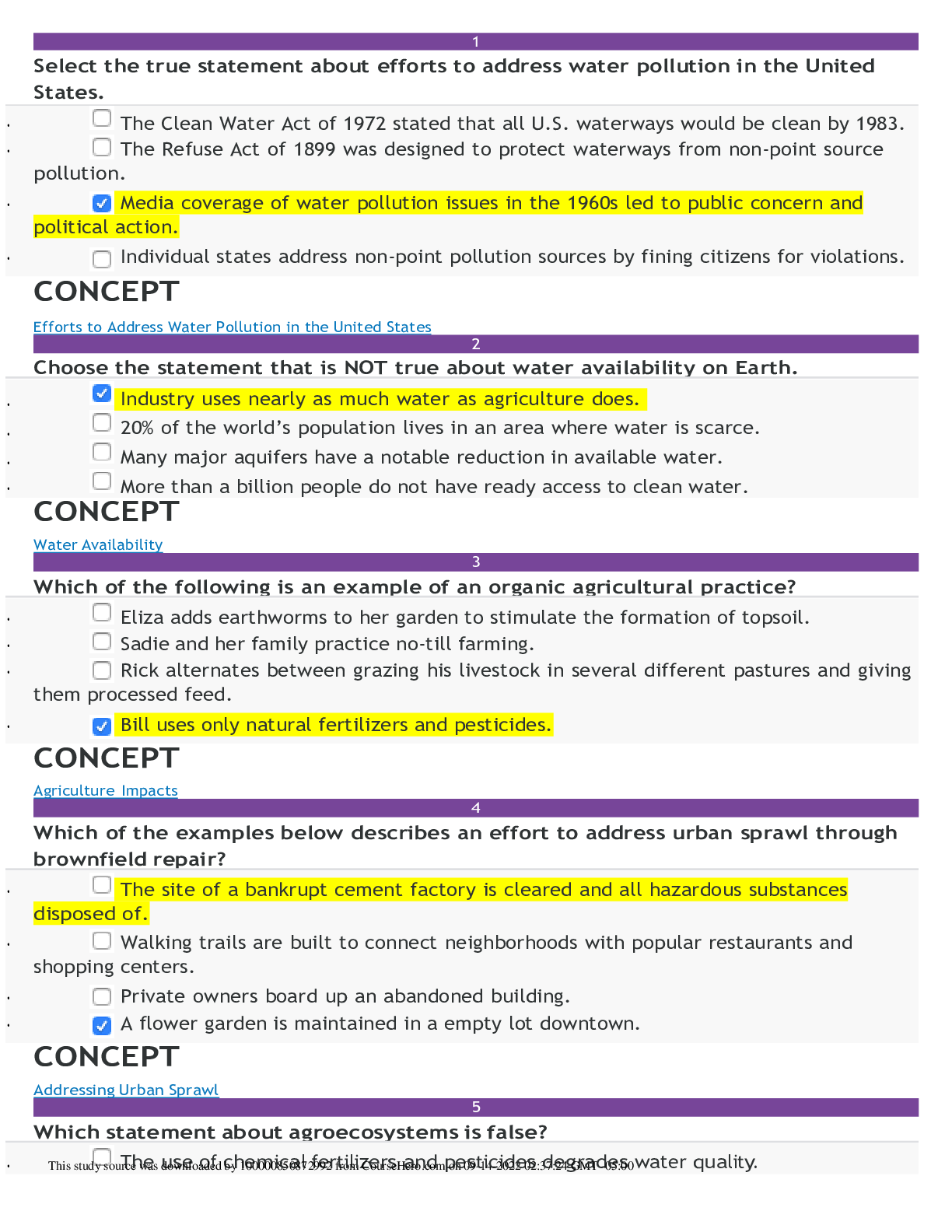
Reviews( 0 )
Document information
Connected school, study & course
About the document
Uploaded On
Oct 10, 2020
Number of pages
5
Written in
Additional information
This document has been written for:
Uploaded
Oct 10, 2020
Downloads
0
Views
103

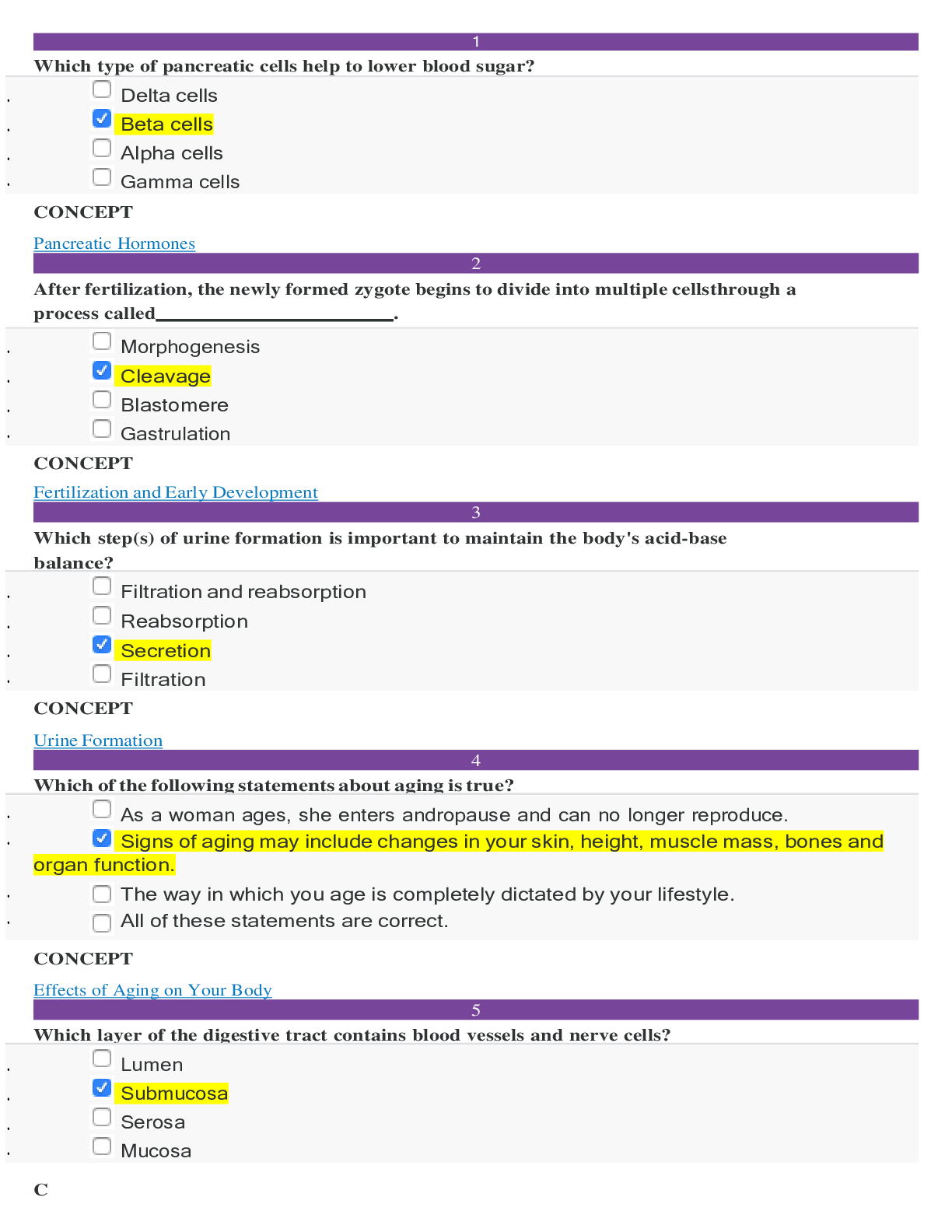
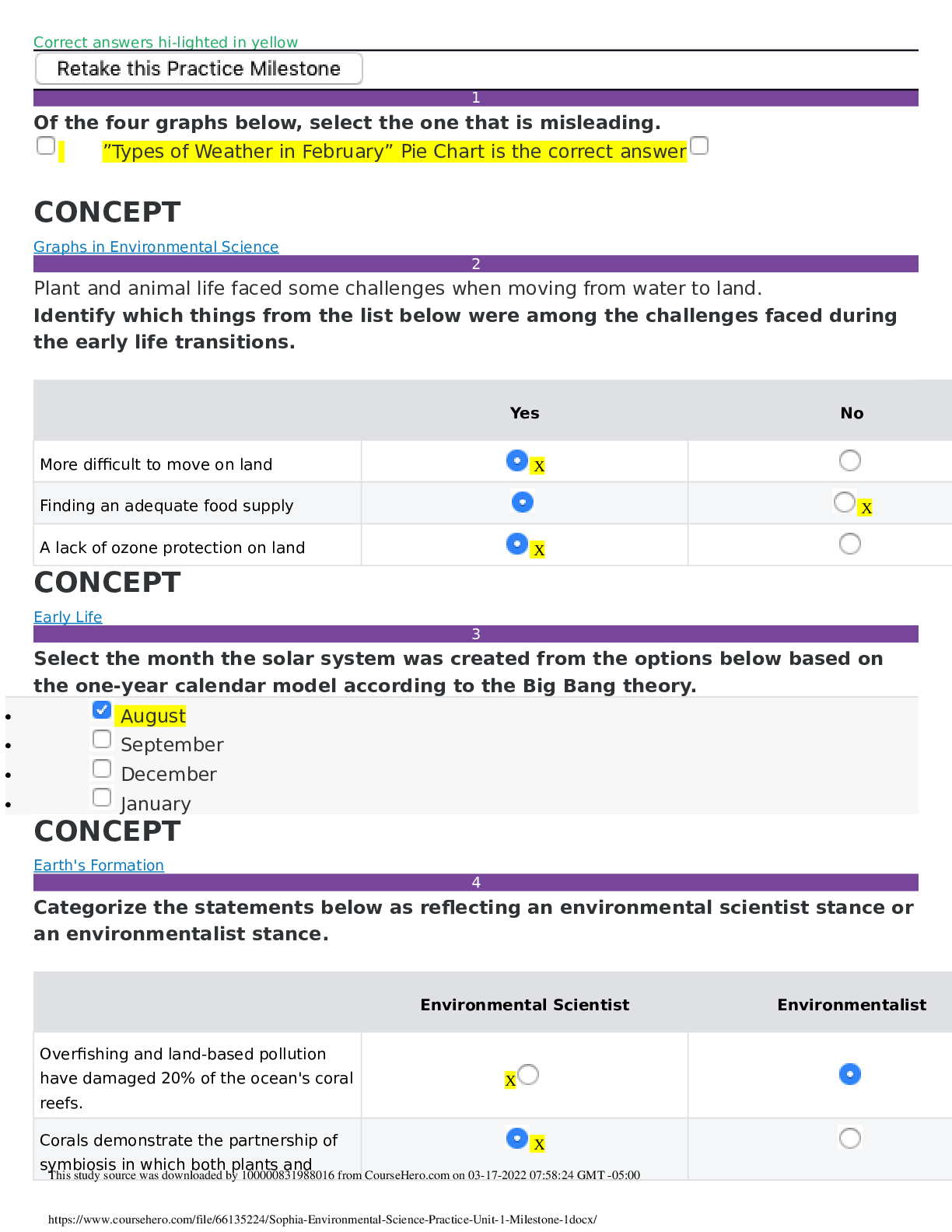
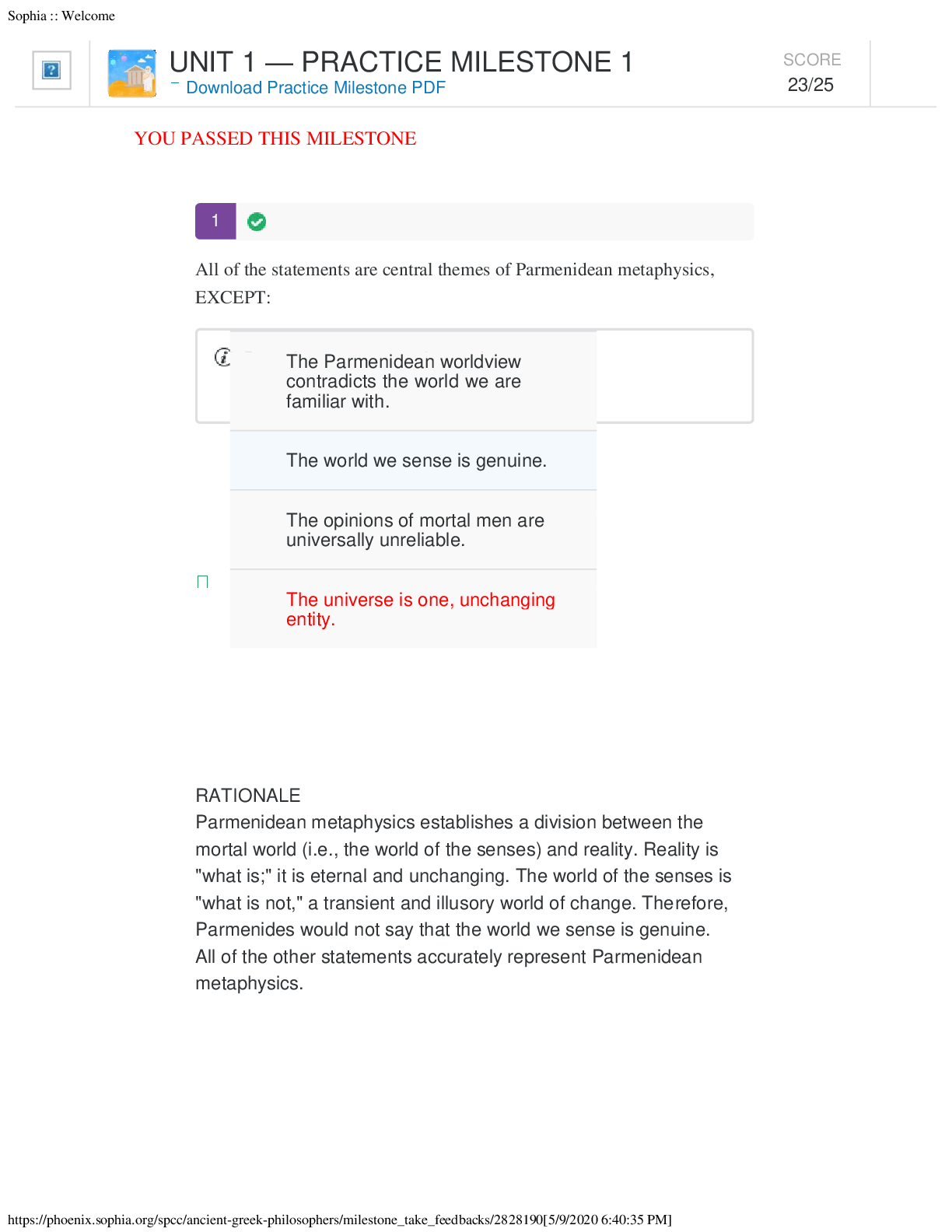

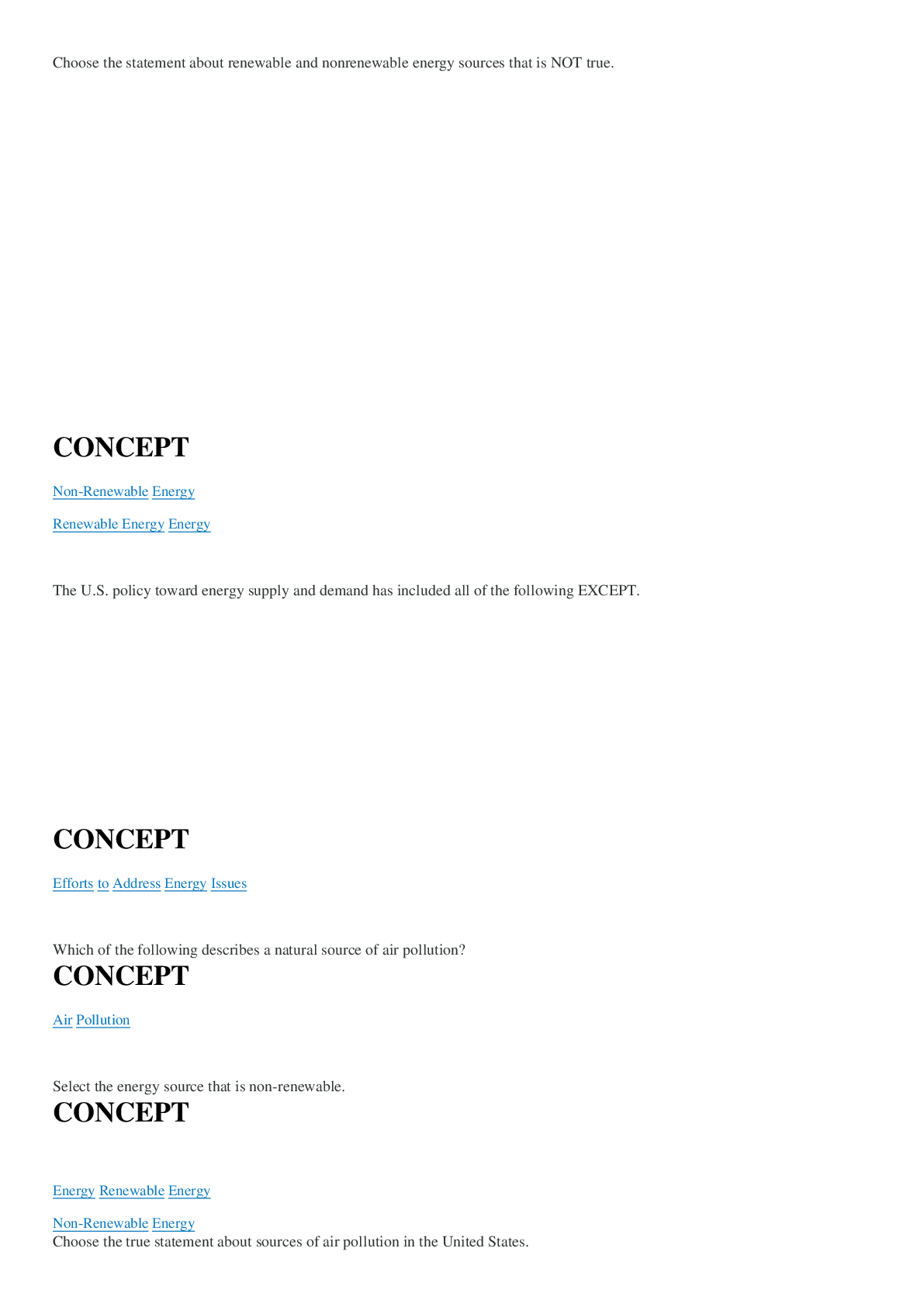

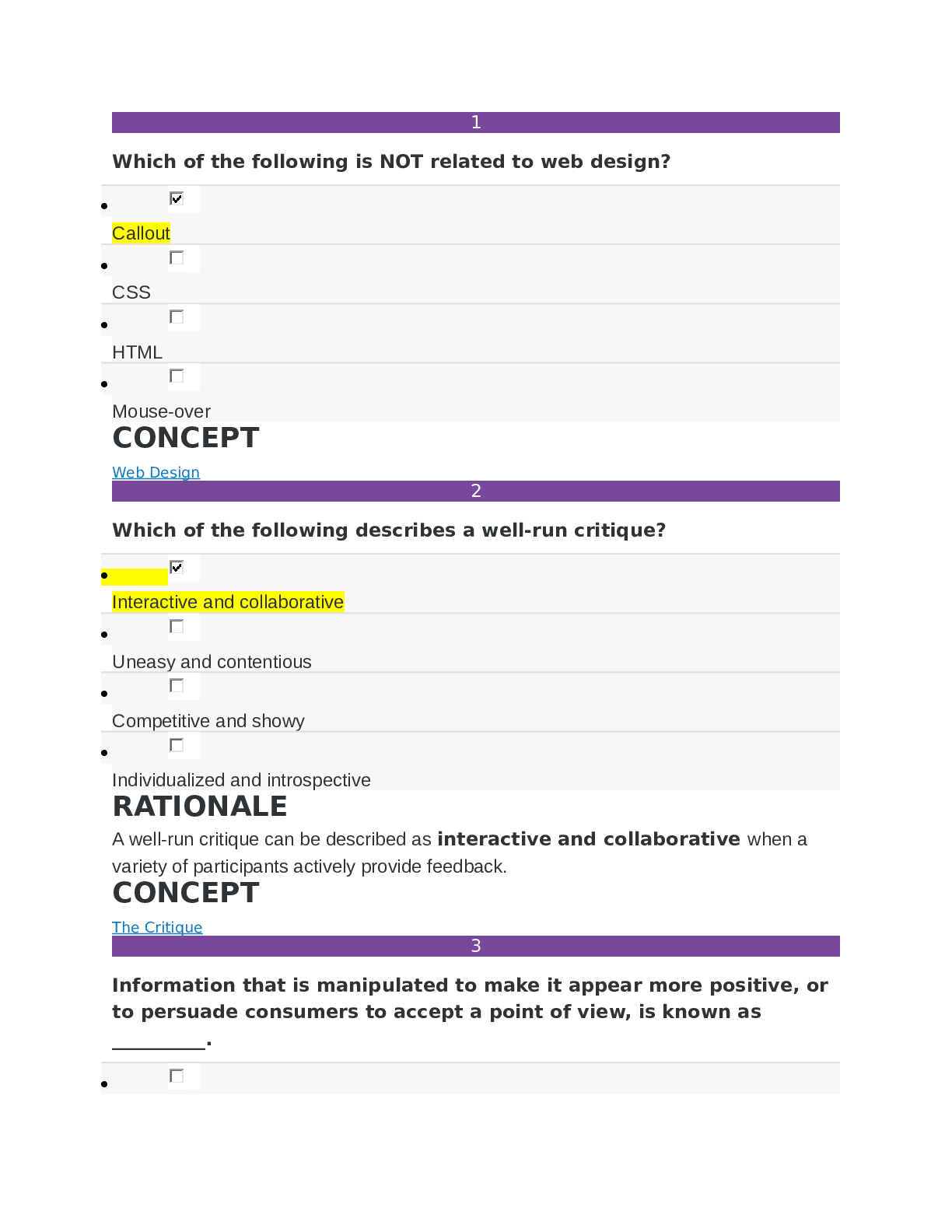

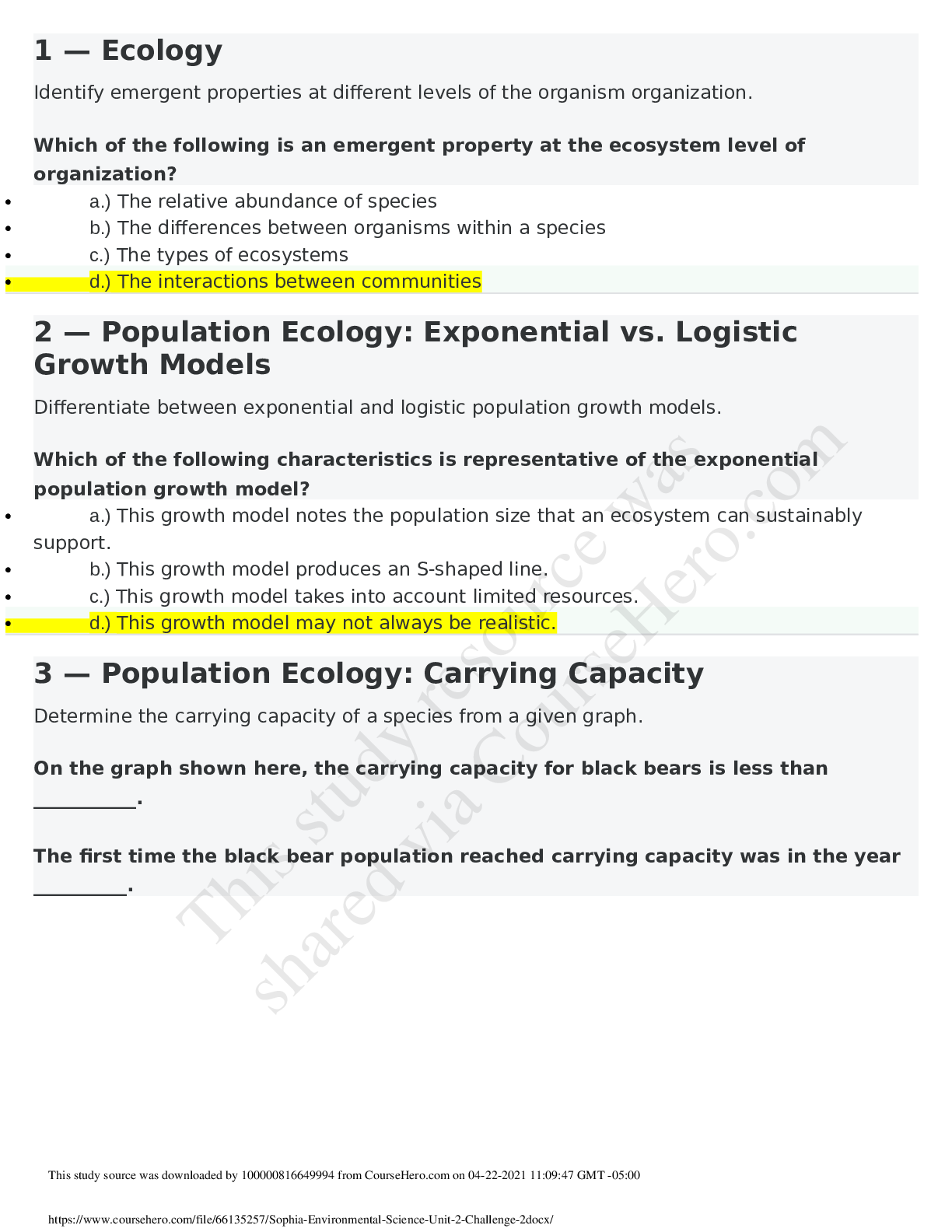
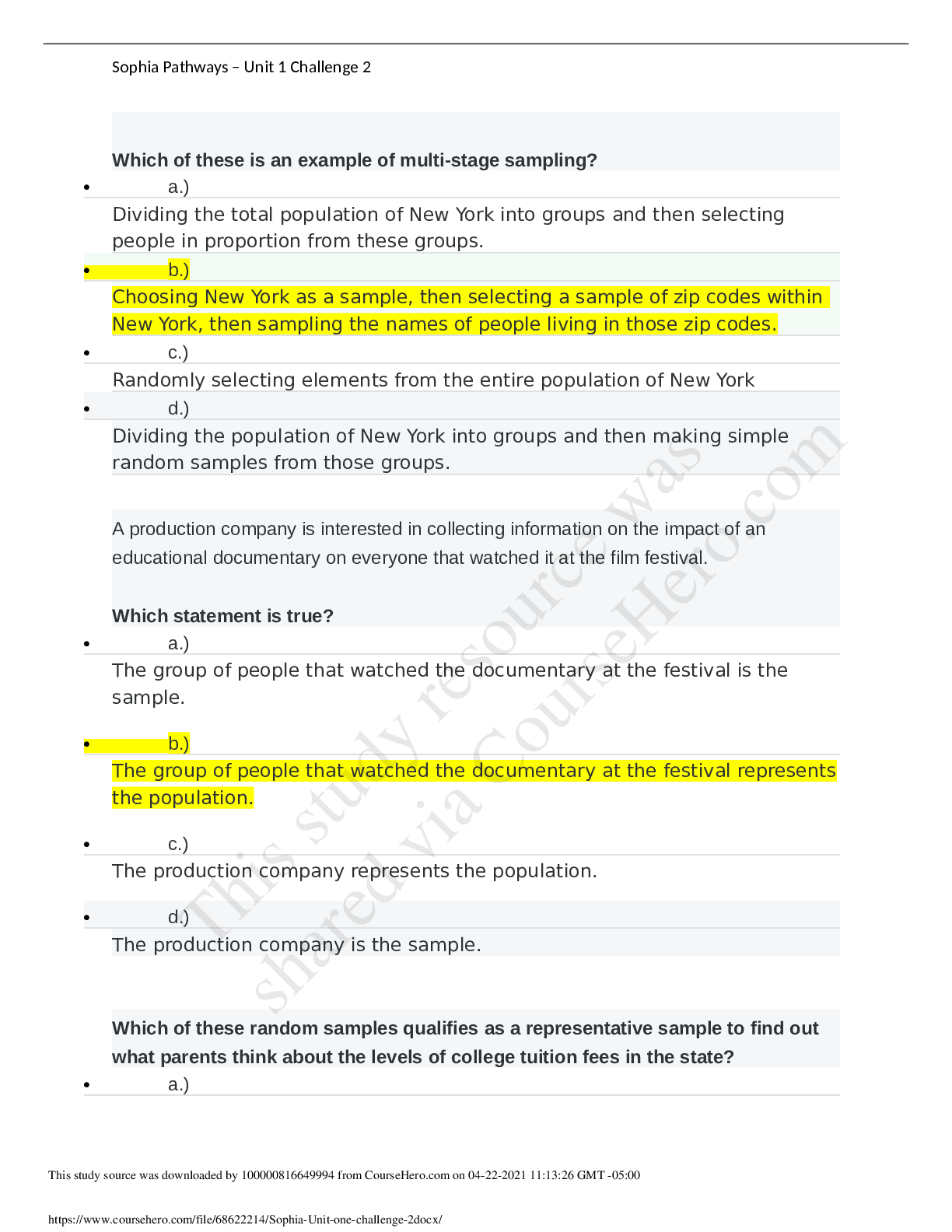

 – Ashford University.png)
 – Ashford University.png)

